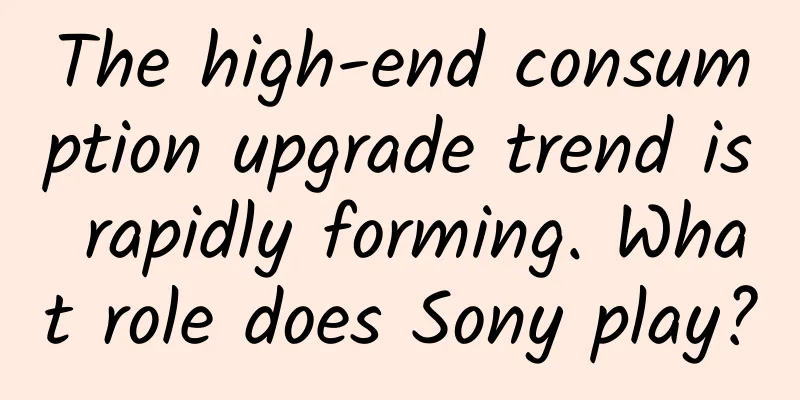The high-end consumption upgrade trend is rapidly forming. What role does Sony play?

|
Nowadays, with the changes in China's consumption structure and the structural reform of the color TV industry, more and more TV companies are trying to get out of the quagmire of price wars and give up struggling in the low-end market. The color TV industry has ushered in high-end development. High-end, high-definition TV products have begun to gradually subvert traditional home appliances, and innovative technologies with higher technological content will gradually become standard configurations of color TVs. According to data, 55-inch and 65-inch HDR TVs accounted for more than 70% of the entire market in 2016. With the excellent performance of high-end products, traditional TV brands accounted for 80% of the domestic sales. The reason why China's high-end color TV market has been able to quickly occupy the market is that on the one hand, it is due to the increase in Chinese family income, and on the other hand, it is influenced by a series of high-end display technology products such as 4K and HDR installed internally, which ultimately formed a new high-end consumption situation that was ignited by internal and external coordination. The high-end color TV market has arrived and consumers are gradually accepting it. Whether people need smart TV is no longer a question worth discussing. The only controversial question is: what kind of smart TV do people need? Some manufacturers emphasize content, some manufacturers pay attention to configuration, and some manufacturers use low price as a magic weapon. However, if we want to summarize the success of Internet smart TVs in the past two or three years, "cost performance" is the undisputed chief contributor - similar stories are playing out in the fields of smartphones and so on. People always like to spend less money to buy better things or services. We can see that in major shopping malls last year, although the number of shoppers decreased compared with previous years, the showrooms of high-end home appliance brands such as Sony were crowded. Some sat on the sofa to experience Sony's Z9D TV launched last year, enjoying the sense of presence brought by the large screen and blockbuster movies; others measured the size to see if it could fit on the TV wall at home. High-end TVs are no longer just mascots in shopping malls. In the past, more people asked about high-end TVs than bought them. Since last year, the number of people asking about them has remained the same, but the difference is that more people are buying them. Many people already have LCD TVs at home and want to upgrade them, and they specifically want to buy large-screen and high-end ones. " Currently, consumers have gradually accepted the high-end market, but in today's Internet era, many disruptors in the TV industry have put the industry in an awkward situation where the volume of sales does not increase revenue. Although such a situation can make up for the profit space compressed by low prices through membership systems and content, it obviously makes it a luxury to make a large profit. This means that if you want to make a large profit, you must get out of the quagmire of price wars, otherwise you either continue to struggle in the low-end market or collectively besiege the high-end market to plunder market profits. Such a signal was completely released in the second half of 2016, but it is not enough to just get out of the low-price quagmire. In the future, the status of TV manufacturers will still be determined by technology, services, and content. Technology, service and content remain the primary goals of high-end TV development Occupying the commanding heights in technology is undoubtedly the "nuclear weapon" in commercial competition, which can be seen from Samsung. In terms of LCD panels, Samsung has absolute say, and its supply of curved screens directly determines the product update rhythm and pricing power of some TV manufacturers. In addition, consumption upgrading became the main theme last year, and the improvement of people's purchasing power is also the key to the rapid arrival of high-end TVs. The characteristics of consumption upgrading are undoubtedly the weakening of price factors, the enhancement of brands and services, a more complete after-sales service system, more guaranteed product quality, and more humane sales strategies. Of course, doing the first two points well is only half of the success. Content is the key. Many examples have been successful before. For example, Skyworth, Hisense, TCL and others have begun to cooperate with content providers such as iQiyi and Tencent Video. For example, Samsung's content partners have added Wasu TV and CIBN this year. Content platforms want to occupy users' terminals, and TV manufacturers need high-quality content to satisfy customers. The establishment of such cooperation is not accidental. It is certain that the future TV industry will be a "product + content" pattern. Sony takes preemptive action to change Faced with such a situation, Sony is also making drastic adjustments to its product lines and business strategies, which can be seen in the recently released high-end TV X9300E. In terms of visual performance, the biggest breakthrough of the X9300E is the use of the 4K HDR image processing chip X1 Advanced Edition, the core of which is the HDR dynamic image reconstruction technology, 4K HDR 14bit smooth gradient, and dual image database. Through independent and precise optimization of the image objects, the transition of details is smoother and the image is more in line with the light and dark contrast and color of the real environment. It can be said to be a major leap in the upgrade process of HDR technology. It has refreshed the industry experts' understanding of the picture quality limit that LCD TVs can achieve, and has become a new favorite in the high-end consumer market. In addition, Sony has further expanded its entertainment resource matrix in terms of content, and has reached in-depth cooperation with strong domestic content resource suppliers such as Wasu, Sohu Video, LeTV Sports, and QQ Music, fully meeting the diverse needs of users of different age groups. At the same time, in terms of product intelligence and interactive experience, Sony TV has always been at the forefront of the industry, leading the optimization and upgrading of smart TV experience. Sony's new products lead the high-end color TV market In 2016, the Chinese color TV market ushered in the era of large-screen fever. Many products with a size of more than 50 inches achieved more than three-digit growth. The high-end large-screen market became the fastest growing category in the color TV industry in 2016. At the same time, it will continue to maintain double-digit growth in 2017. Industry giants led by Sony have set off a new trend of high-end consumption, promoting the integration of hardware, content and user experience. As a major sales battlefield on par with Europe and the United States, the Chinese market is of great significance to Sony. In fact, as early as 2014, Sony split its TV business, insisting on taking the route of "high value-added products" and not following the trend of playing with cost performance. Now it seems that this decision was foresighted. Sony bet on the right thing and took the lead in a relatively less competitive market segment. Since Sony entered the Chinese market, whether it was the CRT, LCD or OLED era, it has been able to bring different display technologies to their full potential. High-quality sound and picture are the beliefs of Sony TV. Focusing on high-end products and serving consumers who have a higher pursuit of quality life also caters to the trend of the evolution of the Chinese consumer market. With the increase of high-end consumer groups in China and the rise of middle-class consumption, the concept of cost-effectiveness is becoming outdated, and high-quality consumption will be increasingly favored by the market, and Sony's advantages will become increasingly obvious. In fact, it is difficult to upgrade low-end products to high-end ones, but it is relatively easy to upgrade them to high-end ones. It is difficult for Volkswagen to snatch BMW's target group, but BMW can continue to penetrate the low-end and mid-end markets. Sony can do the same. It seems that Sony's best performance is still to come. As a winner of Toutiao's Qingyun Plan and Baijiahao's Bai+ Plan, the 2019 Baidu Digital Author of the Year, the Baijiahao's Most Popular Author in the Technology Field, the 2019 Sogou Technology and Culture Author, and the 2021 Baijiahao Quarterly Influential Creator, he has won many awards, including the 2013 Sohu Best Industry Media Person, the 2015 China New Media Entrepreneurship Competition Beijing Third Place, the 2015 Guangmang Experience Award, the 2015 China New Media Entrepreneurship Competition Finals Third Place, and the 2018 Baidu Dynamic Annual Powerful Celebrity. |
<<: Toyota considers acquiring technology companies to ensure autonomous driving
>>: Tesla Roadster to accelerate from 0 to 100 km/h in less than 2 seconds, to be launched in 2019
Recommend
Didi Zhang Wensong: Technology changes life, using big data to "solve traffic jams"
【51CTO.com original article】 “ Zhang Wensong: Cha...
Good news for wound healing: snails on French tables are not only delicious but also useful!
Produced by: Science Popularization China Author:...
Guangzhou lawyer mini program development function, lawyer legal consultation mini program development how much does it cost?
Recently a friend consulted me and wanted to make...
When TV becomes "a smartphone with a larger screen", the living room becomes the target of competition
In a Gome electrical appliance store in Shuangjin...
Is Huaihua under lockdown in 2022? Can I still enter Huaihua now? Attached with the latest notice
Recently, new local outbreaks have occurred in ma...
The best sound of domestic iPhone 6! Experience of Big Coke 3
Although the latest iPhone 6 and iPhone 6 Plus ar...
[Daiyu Finance] Pantaoyuan Swallow Returns Strategy Swallow Style Strategy Third Style Returning Slowly on the Road
[Daiyu Finance] Pantaoyuan Swallow Returning Stra...
It turns out that AI can be used in this way! Visit the AIGC Innovation Center in Turing Town and explore different artificial intelligence
【Science entry: AIGC】 This cool term is the abbre...
How can coal complete the magnificent transformation from "black" to "white"?
Editor's note: Millions of IPs create science...
AutoNavi Product Manager: Good voice navigation is definitely not just for Lin Chiling and Guo Degang
Recently, AutoNavi Map released a funny version, ...
Is it worth it? What can we get by spending 10,000 yuan to modify the workstation?
In his book The Meaning of Work, James Suzman, an...
What exactly is “zombie corn”? What problems could arise from eating so-called “zombie corn”?
Recently, a video of a blogger exposing a middlem...
Does the rumored ninth planet in the solar system really exist?
How many planets are there in the solar system? E...
Soil is made of decayed matter? No
Every day, people are born on Earth, and every da...
Android 8.0, the savior of domestic mobile phones, is coming soon, and its fluency is comparable to that of Apple iOS
Android and Apple have been fighting for so many ...









